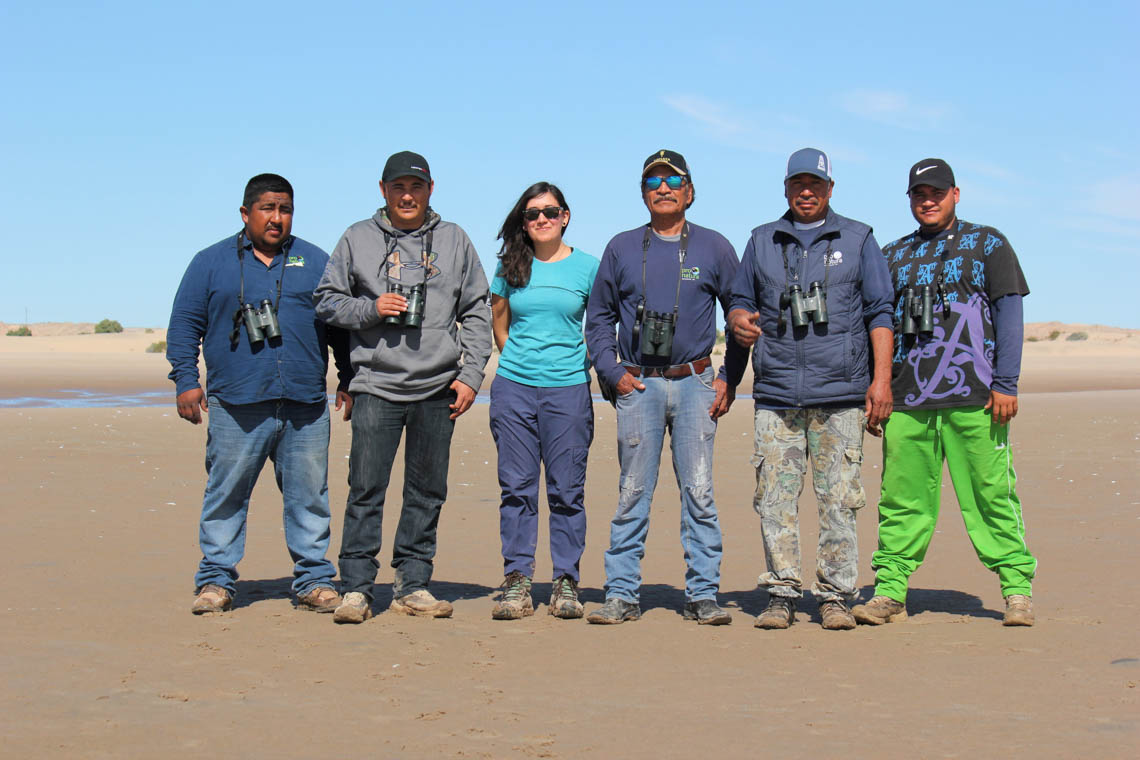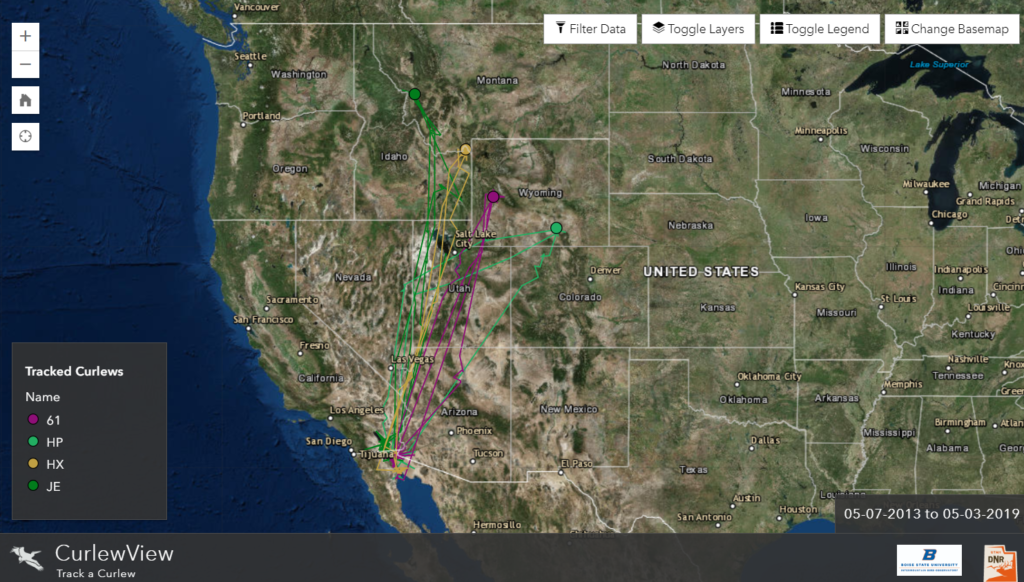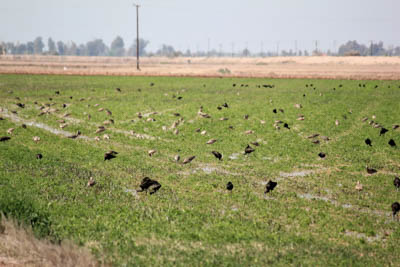
The “Curlew Crew” in Santa Clara, Sonora, Mexico. From left to right, Juan Carlos Medina, Benito Rocha, Erica Gaeta, Juan Butron, Jose Juan Butron, Juan Angel Butron (photo by Erica Gaeta).
By Erica Gaeta, Seasonal Field Technician, Terra Peninsular
The Long-billed Curlew (Numenius americanus) is the largest shorebird in North America and relies on a variety of grassland, agricultural, and coastal habitats. It is a species of conservation concern due to population decline, caused by a variety of factors including habitat loss and human disturbance. While numerous studies have been conducted across the breeding and wintering range in the western United States and Canada, limited information is available regarding wintering ecology of Long-billed Curlews in Mexico.

Long-billed Curlew feeding in an asparagus field near San Luis Rio Colorado, Sonora, Mexico (photo by Erica Gaeta).
Since 2013, Intermountain Bird Observatory (IBO) led by Dr. Jay Carlisle, has worked with many partners to track Long-billed Curlews from breeding areas in the Intermountain West to wintering areas in California and Mexico, including locations in the SJV region. Placing satellite transmitters on birds expanded the understanding of this species beyond their short breeding season by learning more about migratory routes, stopover sites, and wintering locations. Many tagged individuals were migrating and wintering in Mexico, with a small concentration in the arid borderland region of the Mexicali Valley. In 2016, Carlisle presented this research to the SJV Management Board. This led to the formation of new partnerships for collaborative curlew research and conservation with a focus on connectivity with Mexico.
Funded by the SJV Awards Program, this project is a binational effort led by Dr. Eduardo Palacios, SJV and Terra Peninsular board member, and research scientist from Centro de Investigación Científica y de Educación Superior de Ensenada. It is co-led by Dr. Jay Carlisle at IBO and Boise State University. Leading the field work is Erica Gaeta, a seasonal field technician from Terra Peninsular and former lead curlew technician for U.S. Geological Survey and IBO. Another key collaborator on our team is Pronatura Noroeste, whose staff, including Juan Butron, Jose Juan Butron, Juan Carlos Medina, Benito Rocha and Juan Angel Butron, provided critical field assistance, local knowledge and logistical support.
The purpose of this project is to: 1) Identify wintering Long-billed Curlews in Mexicali Valley and northern Gulf of California with the use of satellite transmitter data, and 2) Coordinate wintering Long-billed Curlew monitoring to gain valuable information on wintering habitat preferences, roosting and foraging behavior, and document threats that curlews face.

Map of the Long-billed Curlews tagged in the Intermountain West that traveled to the Mexicali Valley, Mexico (Image courtesy of Boise State University, IBO, and Utah Department of Natural Resources).
We initiated our pilot study in January and continued until early March of 2019. We identified three wintering Long-billed Curlews with satellite transmitters in the Mexicali Valley. These were tracked from their breeding grounds in Wyoming, Montana and Idaho. Named after their alphanumeric flag we had: “61” (male, trapped in New Fork, Wyoming), “JE” (male, trapped in Florence, Montana), and “HP” (female, trapped in Saratoga, Wyoming). On the coast in the Northern Gulf of California there was one curlew “HX” (female, trapped in Island Park, Idaho). We successfully located 65 curlew flocks utilizing a variety of crops such as alfalfa, wheat, asparagus, Sudan grass, and onion. Given human demands for water use and drought potential in the arid borderland region, this information is important to share with landowners and managers to not only maintain agricultural productivity, but to benefit curlew populations.
We were also able to identify various threats, both natural and anthropogenic, present in the Mexicali Valley that can affect Long-billed Curlew. We most frequently observed natural predators or disturbance events by Peregrine Falcon, Northern Harrier, Red-tailed Hawk, and coyote who were in close proximity and/or flushing Long-billed Curlews. As for anthropogenic disturbances, we observed that some landowners use lethal and/or non-lethal techniques to deter birds from their fields. Notably, a few of the wheat growers reported a negative perception of curlews and other waterbirds because they believe birds cause problems to agriculture during the initial seeding and watering phase. When seeds are pushed too deep in the soil or birds trample seedlings, it inhibits its growth and reduces crop yield. The non-lethal techniques used to deter birds were flushing (hiring someone to physically flush birds), and use of compressed air cannons or fireworks (sound deterrent). The lethal technique was shooting birds with a firearm.

Long-billed Curlew and White-faced Ibis feed in an alfalfa field outside of San Luis Rio Colorado, Sonora, Mexico (photo by Erica Gaeta).
While we did not observe poaching, during four surveys, landowners or guards questioned our presence on their land. When we shared information regarding our study, they mentioned to us the issue of poaching by U.S. citizens. One landowner described finding several birds shot on his property. Further investigation is needed regarding the perception of Long-billed Curlews by agricultural workers and landowners (especially those who grow wheat), along with hunting demands and poaching in the Mexicali Valley.
As we continue our work in the Mexicali Valley, we hope to conduct formal interviews with local landowners and agricultural workers to gather more information regarding their perception of Long-billed Curlews. Once we can confidently assess the magnitude of these identified threats, we plan to collaborate with landowners and managers. We hope to develop techniques to benefit both crop productivity and Long-billed Curlew habitat by applying science to improve land use practices in agricultural areas in the Mexicali Valley, Mexico.


 English
English  Español
Español